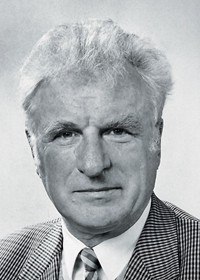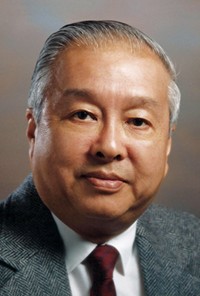Advertisement
Grab your lab coat. Let's get started
Welcome!
Welcome!
Create an account below to get 6 C&EN articles per month, receive newsletters and more - all free.
It seems this is your first time logging in online. Please enter the following information to continue.
As an ACS member you automatically get access to this site. All we need is few more details to create your reading experience.
Not you? Sign in with a different account.
Not you? Sign in with a different account.
ERROR 1
ERROR 1
ERROR 2
ERROR 2
ERROR 2
ERROR 2
ERROR 2
Password and Confirm password must match.
If you have an ACS member number, please enter it here so we can link this account to your membership. (optional)
ERROR 2
ACS values your privacy. By submitting your information, you are gaining access to C&EN and subscribing to our weekly newsletter. We use the information you provide to make your reading experience better, and we will never sell your data to third party members.
People
Obituaries
by Rachel Petkewich
November 14, 2005
| A version of this story appeared in
Volume 83, Issue 46
Frederick V. Brutcher Jr., 82, an associate professor emeritus of chemistry at the University of Pennsylvania, died on June 14.
A native of Mansfield, Mass., Brutcher served more than three years in the U.S. Army in the chemical warfare service and in the infantry as a second lieutenant. After V-J Day in 1945, he taught in the University of Okinawa's chemistry department.
In 1947, he received a B.S. in chemistry from the University of Massachusetts. He received his Ph.D. in 1951 from Yale University, where he and his adviser discovered the 1,3-diol cleavage reaction. While he was a postdoctoral student with Robert B. Woodward at Harvard University, they discovered the iodine-silver acetate wet acetic acid reaction for the synthesis of cis-glycols from olefins.
In 1953, Brutcher joined the chemistry department at the University of Pennsylvania. There, with Theodore Roberts and Nancy Pearson, he conformationally analyzed cyclopentane, inventing the names envelope and half-chair. Later, with William Bauer, Eric Leopold, and R. C. Lugar, he analyzed ring D of the steroids and alkyl cyclopentanes with physical data and mathematical techniques. Although he retired 20 years ago, he continued to work on simplifying conformational mathematics.
An emeritus member, Brutcher joined ACS in 1977.
Wilmer K. Fife, 71, a professor emeritus of organic chemistry, died on Sept. 30 after a long battle with Parkinson's disease.
Fife was born in Ohio. He received a B.S. in chemistry in 1955 from Case Institute of Technology and a Ph.D. in organic chemistry in 1960 from Ohio State University. After teaching at Muskingum College, in Ohio, and completing two fellowships at Harvard and Columbia Universities, he was recruited to chair the chemistry department at Indiana University-Purdue University Indianapolis. He taught undergraduates, advised a research group working on phase-managed organic synthesis and synthetic polymeric catalysts with enzymelike properties, and obtained many patents for the university.
He is survived by his wife, Betsy; three children; and four grandchildren. He joined ACS in 1955.
G. Robert Greenberg, 87, a biochemist, died on May 15.
He was born in Minnesota. By 1942, Greenberg had earned both B.A. and M.A. degrees from the University of Minnesota and had developed a unique method for isolating glutamic acid. Two years later at the same university, he defended a Ph.D. dissertation describing spectrophotometric means to study iodination of tyrosine residues in serum albumin and immediately took a job in the department of medicine at the University of Utah, Salt Lake City.
In 1946, he joined a new department studying metabolism and enzymes at Western Reserve University in Cleveland. In the mid-1950s, he discovered a new class of compounds called teichoic acids, which form the cell walls of certain microorganisms. Other work included metabolism studies and elucidating the mechanisms of various enzymes in DNA synthesis and replication. In 1988, at age 70, he was required by law to retire. As an emeritus professor, he taught a graduate biochemistry seminar course until 2004 and continued to do research.
As a radio amateur, he always chose homes that were near the crests of hills and invariably had elaborate winch arrangements to gain great altitudes for his antenna systems.
Vladimir Petrow, 91, a pharmaceutical researcher, died on Aug. 20 after a short illness.
Born in Russia, his family escaped the Bolsheviks in 1919. He grew up in London and received a B.S. in chemistry in 1933, a Ph.D. in 1936, and a D.Sc. in 1947.
Petrow was active in many fields of medicinal research, including steroids, vitamin B-12, oral contraception, prostate cancer, 5-a reductase, osteoporosis, and antiangiogenesis. He held 120 patents. Petrow worked as a lecturer at Queen Mary's College in the U.K. before moving to industry in 1948. He came to the U.S. in 1968 and held adjunct positions at the University of North Carolina School of Pharmacy, Chapel Hill, and Duke University Medical Center's department of pharmacology. In 1978, he joined the faculty of Duke's department of physiology (now cell biology). In 1993, he was recruited to the department of pathology and conducted research there until his death.
Many friends praised Petrow for his extraordinary depth and breadth of scientific knowledge, his patience and kindness as a teacher, and his keen sense of humor.
He is survived by his wife, Merrill. An emeritus member, he joined ACS in 1956.
Leo H. Sternbach, 97, one of the medicinal chemists who developed the antianxiety drugs Librium and Valium, died on Sept. 28. Valium was the biggest selling drug in the U.S. from 1969 to 1980. Earlier this year, Sternbach was inducted into the National Inventors Hall of Fame in Akron, Ohio, for discovery of the benzodiazepine class of compounds.
In what is now Croatia, he was born to a Polish father who ran a pharmacy and a Hungarian mother. Sternbach studied chemistry and pharmacy at Jagiellonian University in Poland, where he earned an M.S. in pharmacy in 1929 and a Ph.D. in organic chemistry in 1931. He worked at the Swiss Federal Institute of Technology, Zurich, but he was told his Jewish heritage would keep him from advancing.
In 1940, Sternbach joined Hoffmann-La Roche. Synthesizing the vitamin riboflavin was his first assignment. At the beginning of World War II in 1941, he and his wife were transferred to the U.S. for their safety. They had Swiss passports, which did not list nationality or religion. While working at a new laboratory in New Jersey, he gained attention for his work with psychiatric drugs but also contributed to anti-infectives, vitamins, and heterocyclic chemistry.
Sternbach was a member of the two-legged rat generation, when chemists tested drugs on themselves and recorded observed effects in lab notebooks.
He worked on 241 patents, 122 publications, and six monographs. Universities around the world bestowed honorary degrees, and professional societies presented him with citations and awards. Roche and Yale University established the annual Leo H. Sternbach Lectureship.
Although he formally retired from Roche in 1973, he came to work almost every day for the next 30 years. I like to keep up with what is going on-not only in chemistry, but in the world, he would remark.
As Sternbach said, I was successful because I loved my work and was completely dedicated, like any true artist.
He is survived by his wife, Herta, two sons, and five grandchildren. An emeritus member, he joined ACS in 1942.
Obituaries are written by






Join the conversation
Contact the reporter
Submit a Letter to the Editor for publication
Engage with us on Twitter